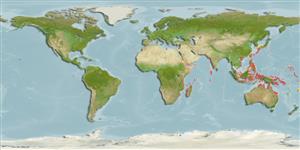Thecostraca |
Balanomorpha |
Balanidae
Environment: milieu / climate zone / depth range / distribution range
Ecology
Reef-associated; depth range 1 - 3 m (Ref. 100014). Tropical
Indo-Pacific.
Length at first maturity / Size / Weight / Age
Maturity: Lm ? range ? - ? cm
Depth range is based on occurrence in Tonga (Ref. 100014); to be replaced with a better reference. Sublittoral (Ref. 99821). Found from coral reef to sandy bottom (Ref. 100014). Also fouls ship hulls (Ref. 100016).
Life cycle and mating behavior
Maturity | Reproduction | Spawning | Eggs | Fecundity | Larvae
Members of the superorder Thoracica are mostly hermaphroditic. Broadcast spawners, fertilization occurs in the mantle cavity. Life cycle: Eggs hatch into planktonic nauplii and leave the mantle cavity. Afterwards, they undergo six naupliar instars succeded by nonfeeding cypris larva (settling stage) which later metamorphose into adults.
Poltarukha, O.P. 2004 An addition to the fauna of coral-inhabiting barnacles (Cirripedia: Balanomorpha) of Vietnam. Russian Journal of Marine Biology 30(4):278-282. (Ref. 7448)
IUCN Red List Status
(Ref. 130435: Version 2025-1)
CITES status (Ref. 108899)
Not Evaluated
Not Evaluated
Threat to humans
Harmless
Human uses
| FishSource |
Tools
More information
Trophic EcologyFood items (preys)
Diet composition
Food consumption
Predators
Population dynamicsGrowth
Max. ages / sizes
Length-weight rel.
Length-length rel.
Length-frequencies
Mass conversion
Abundance
Life cycleReproductionMaturityFecunditySpawningEggsEgg developmentLarvae PhysiologyOxygen consumption
Human RelatedStamps, coins, misc.
Internet sources
Estimates based on models
Preferred temperature
(Ref.
115969): 25 - 29.2, mean 28.5 (based on 1450 cells).
